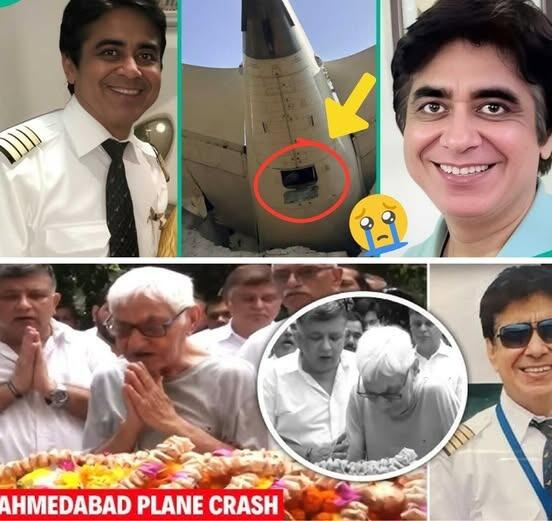SPECULATION SWIRLS: Air India 171 Crash Theories Flood the Internet — Aviation Expert Reveals the One Detail That Could Explain Everything

On June 12, 2025, Air India Flight AI-171, a Boeing 787-8 Dreamliner, crashed seconds after takeoff from Ahmedabad’s Sardar Vallabhbhai Patel International Airport, killing 241 of the 242 passengers and crew onboard, along with 33 people on the ground. The disaster, one of India’s worst aviation tragedies in decades, has sparked a firestorm of speculation across the internet, particularly on platforms like X, where theories range from mechanical failures to sabotage. Amid the chaos of conjecture, one aviation expert has pointed to a single detail—the deployment of the Ram Air Turbine (RAT)—as the potential key to unraveling the mystery. This article explores the leading theories, the critical clue, and the ongoing investigation into what caused AI-171 to plummet just 30 seconds after takeoff.
The Crash: A 30-Second Tragedy

Flight AI-171, bound for London Gatwick, took off at 1:38 p.m. local time with 242 people onboard, including 169 Indians, 53 Britons, 7 Portuguese, and 1 Canadian. CCTV footage verified by the Associated Press shows the aircraft lifting off normally but failing to climb, reaching a maximum altitude of just 625 feet before descending rapidly and crashing into a medical college building in Ahmedabad’s Meghani Nagar. The impact caused multiple explosions, with debris scattering across a 200-meter radius and the aircraft’s tail cone coming to rest atop a hostel building. A single survivor, Vishwaskumar Ramesh, a British national, escaped through an emergency exit, sustaining non-life-threatening injuries.
The black box, comprising the Cockpit Voice Recorder (CVR) and Flight Data Recorder (FDR), was recovered on June 13 and 16, with data successfully accessed by June 25 at the Aircraft Accident Investigation Bureau (AAIB) lab in Delhi. The data revealed a complete system blackout 32 seconds after takeoff and a mysterious coded message transmitted just before the crash. These findings, combined with video evidence, have fueled intense speculation about the cause.
Theories Flooding the Internet
The internet, particularly X, has been abuzz with theories about the crash, ranging from plausible to outlandish. Here are the leading hypotheses circulating online and among experts:
- Dual Engine Failure: Posts on X, including from @NateB_Panic and @RShivshankar, suggest a catastrophic dual engine failure, possibly due to fuel contamination or a bird strike. The deployment of the RAT, a backup power system that activates automatically during major electrical, hydraulic, or dual-engine failure, supports this theory. Aviation expert Dan Bubb, in an interview with Newsweek, noted that the aircraft’s failure to climb could indicate insufficient thrust, potentially caused by engines not receiving enough fuel.
- Improper Flap Settings: Some analysts, including Captain Steve on YouTube, propose that the crash resulted from a loss of lift due to incorrect flap settings. Video footage suggests the wing flaps, critical for generating lift during takeoff, may not have been properly extended. Captain Steve speculated that the co-pilot might have mistakenly raised the flaps instead of the landing gear, causing a sudden loss of lift and a power-on stall.
- Pilot Error: Early speculation pointed to human error, with some suggesting the pilots failed to retract the landing gear or used insufficient runway length. Radar data reviewed by Newsweek indicates AI-171 may have used only 1,900 meters of runway, less than the recommended 2,500 meters for a fully loaded 787 in hot conditions (40°C in Ahmedabad). However, Tata Sons Chairman N. Chandrasekaran defended the crew, calling them “exceptional pilots” with no prior safety concerns.
- Sabotage or Cyberattack: Though ruled out prima facie by sources cited on X, some users speculated about sabotage or a cybersecurity breach, particularly due to the coded message transmitted before the crash. The non-standard signal has raised questions about whether an external actor could have interfered with the aircraft’s systems, though no evidence currently supports this theory.
- Maintenance or Design Flaw: The aircraft’s maintenance history has come under scrutiny, despite Chandrasekaran’s assertion that AI-171 had a “clean history” with a new right engine installed in March 2025 and the left engine serviced in 2023. Some experts, like Amit Singh speaking to NPR, argue that India’s aviation safety culture and regulatory oversight may have gaps, potentially allowing maintenance issues to go undetected.
The Critical Clue: The Ram Air Turbine
Aviation expert Scheibner, in a YouTube analysis, highlighted the deployment of the RAT as the pivotal detail that could explain the crash. The RAT, a small propeller-like device, deploys automatically to provide emergency power in the event of a total loss of electrical or hydraulic systems or both engines failing. Video evidence, described by Scheibner as showing a “small gray dot” beneath the right wing, confirms the RAT was deployed during AI-171’s brief flight. This finding, reported by The Wall Street Journal on June 18, shifts the focus toward a dual engine failure or a complete system blackout, as the RAT would not deploy otherwise.
Scheibner noted that the RAT’s deployment places the dual engine failure theory “in first place,” though the root cause remains unclear. He ruled out bird strikes and fuel contamination as less likely, given the lack of visible sparks or flames in the footage. The RAT’s activation suggests the aircraft lost all primary power sources, leaving the crew with minimal control. The CVR, currently under analysis, captures the pilots’ attempts to deploy the RAT and troubleshoot the blackout, but the 30-second window was too brief for recovery.
The Investigation: Black Box and Beyond
The AAIB, with support from the U.S. National Transportation Safety Board (NTSB) and the UK’s Air Accidents Investigation Branch, is leading the investigation. The black box data, accessed on June 25, shows a system blackout at 32 seconds, with all critical systems—electrical, hydraulic, and avionics—failing simultaneously. The coded message, transmitted at 58 seconds, is being analyzed to determine if it was an automated diagnostic signal or a corrupted transmission. The FDR also indicates the landing gear remained extended, a mystery noted by experts like Alastair Rosenschein and Paul Edwards, who suggest the pilots may not have had time to retract it or believed they could attempt an emergency landing.
Investigators are also examining the wreckage, particularly the engines, to determine if they were producing power at impact. Peter Goelz, a former NTSB managing director, told the BBC that turbine damage can reveal whether the engines were operational. The aircraft’s maintenance logs, fuel quality, and compliance with regulatory standards are under review, with India’s Directorate General of Civil Aviation (DGCA) ordering additional inspections of Air India’s 787 fleet.
Public Reaction and Industry Impact
The crash has shaken public confidence in Air India, which was undergoing a transformation under Tata ownership since 2022. Posts on X, such as from @TimesAlgebraIND, highlight fuel contamination as a possible cause, while others, like @OsintUpdates, emphasize the black box recovery as a step toward answers. The tragedy has also raised questions about Boeing’s 787 Dreamliner, the first of its kind to suffer a fatal crash. Boeing has deferred to the AAIB for comment, but the incident adds to the company’s ongoing scrutiny following previous 737 Max crashes.
Aviation safety experts, like Professor Graham Braithwaite from Cranfield University, stress that takeoffs are critical phases where rapid problem-solving is essential. The 787’s advanced systems, designed with multiple redundancies, make the complete blackout “very surprising,” according to Professor John McDermid. The investigation’s preliminary report, expected within three months, will likely address these anomalies and propose new safety protocols.
Conclusion
The crash of Air India Flight AI-171 has left a nation grieving and the aviation world searching for answers. The deployment of the RAT, as highlighted by Scheibner, points to a catastrophic loss of power, likely due to a dual engine failure or system blackout. While internet theories abound, from pilot error to sabotage, the black box data and ongoing investigation will be crucial in determining the truth. As families mourn and Air India faces intense scrutiny, the focus remains on ensuring such a tragedy never happens again. The RAT, that “small gray dot,” may indeed hold the key to unlocking the mystery of AI-171’s final 30 seconds.